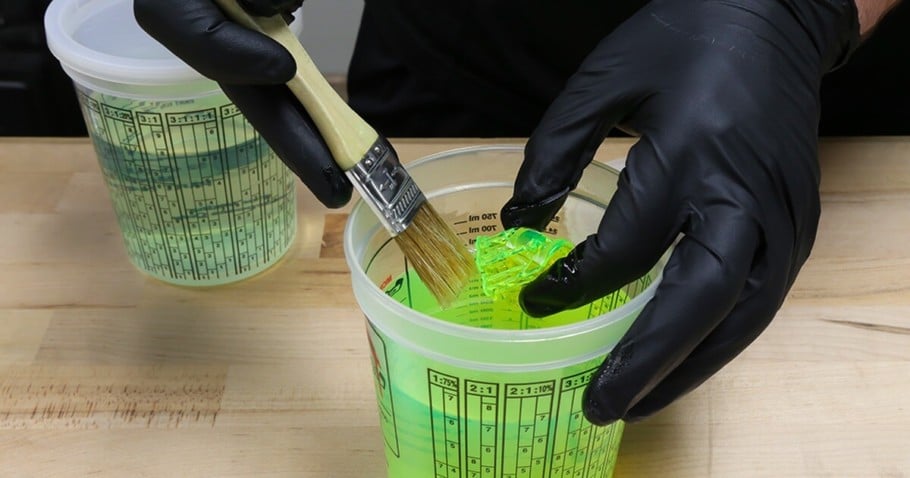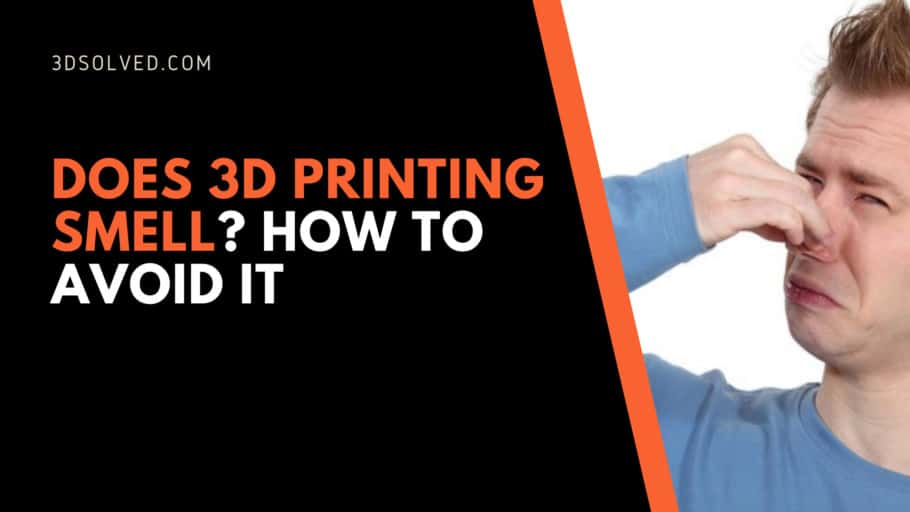You might have read and researched a little bit about 3d printing even up to the point where you are about to buy your first one. Among many of the questions you have, safety and comfort are not to be taken lightly, and one issue that could be annoying, is having your 3d printer working in your home office next to you. In addition to the noise, you might be wondering about the smell of the thermoplastics. In short, does 3d printing smell?
The answer, no matter what kind of technology you are working with, is yes. However, the smell 3d printers emit does depend on what printer you are choosing to use. FDM printers can use a wide array of thermoplastic, of which PLA aroma is tolerable and non toxic by most definitions. On the other hand, ABS smell is not only quiet, but its fumes are also toxic. Last but not least, PETG and Nylon are odorless but toxic, meaning that proper ventilation is a must.
Keep reading to learn about what smells 3d printers can emit and how to know which one is suitable for you.
| Filament | What does it smell like? | Is it toxic? |
| PLA | Sweet, sour aroma, like honey | Not as much as other filaments |
| ABS | Burned plastic | Yes |
| PETG | It is odorless | Yes |
| TPU | Quite sour, almost sweet | Yes |
| Nylon | It is odorless | Yes (most toxic filament) |
| Polycarbonate | A faint scent of plastic | Yes |
How does 3D printing work?
After designing the object we are willing to print, 3d printers will melt a particular material (the most common being thermoplastics) and then deposit a tiny layer of it under the control of a computer. After a layer cools down, it will repeat this operation until the designed item is created.
3d printers basically create objects extruding a molten material, layer after layer, guided by CAD (computer-aided design). But even though this process may seem easy and intuitive, they are complex machines and the number of printing methods and printing materials is really huge.
The two main 3D Printing technologies (FDM vs SLA)
The Fused Deposition Modeling (FDM) is the most common printing technology: it melts thermoplastics to then extrude them through a nozzle with a small diameter that will “draw” layers of plastic to create an object. There is not only one kind of plastic available: you can choose between various types of plastic filaments that will be different in consistency, melting temperature and smell.
Stereolithography (or SLA), on the other hand, is a printing method suited for objects with better heat resistance, or to print something more detailed and complex. This method is commonly known as resin printing, since it will rely on liquid resin.
FDM 3D Printer smell

It is not difficult to understand why FDM printers smell when at work: when plastic reaches its fusion point, it releases gases and volatile organic compounds known as VOCs. As I said, there are various types of plastic filaments for FDM printers and the different chemical compositions of the plastic will give them a different smell when they melt.
Obviously, each filament will have a different consistency and fusion point, so let’s go over each one:
PLA: Polylactic Acid (PLA), one of the most common filaments, is made of biodegradable thermoplastics and it easily prints at temperatures between 180 and 220. Its smell is noticeable but not unpleasant. Additionally, it is considered to be almost nontoxic. Having said that, it is never recommended to remain in a closed environment next to working 3d printers for prolonged periods of time.
ABS: it is known as one of the toughest filaments that were initially available a few years back available, and requires temperatures of approximately 250 to melt. It emits a strong odor that is unpleasant by most standards. Additionally, its fumes are toxic, meaning that proper ventilation is required. Due to these drawbacks, ABS has lost popularity and has been mostly replaced by newer thermoplastics.
PETG: Polyethylene Terephthalate (PET) will grant us resistant and flexible items, but at a much higher printing temperature than PLA (between 220 and 250). PETG is a variant of this plastic, and both of them do not produce any odor when melted. You should still not make a habit out of being near a printer working with PETG, since its fumes are toxic.
- TPU (thermoplastic polyurethane): it is said to be flexible and able to resist abrasions. Its smell is described as not sweet, yet not unpleasant, making it a good material to print for long times.
- Nylon: One of the strongest materials (its melting point is approximately 240), it is versatile and cheap, but also dangerous. In fact, Nylon does not smell, but it is highly toxic.
- Polycarbonate: it is resistant and transparent, but requires the highest temperature to melt (between 260 and 310). Its smell is not particularly strong, but toxic nonetheless. Having said that, most printers are not able to print polycarbonate due to its high melting temperature. So, unless you are dealing with a high-end professional machine, do not worry about this thermoplastic.
Are FDM 3D printer fumes considered to be toxic?
Not all fumes from FDM printers are toxic. The ones that are considered to be most dangerous are Polyamide fumes, since they are completely odorless, and you could be inhaling them for a long time without noticing.
Other filaments, such as PLA, emit less dangerous particles due to their biodegradable composition. The good news is that when using an FDM printer, the smell will mostly fade a few minutes after turning it off. However, no matter what thermoplastic you use, I would recommend to place the printer in a ventilated room to avoid breathing microparticles, especially if the filament you chose is Nylon (polyamide).
Resin Printer smell (They do, a lot)
Some people may believe resin is a good way to avoid unpleasant smells when using a 3d printer, but in fact, resin turns out to be even smellier than most thermoplastics used in FDM printers. The odor of this material is strong and persistent, and unlike plastics -which emit fumes and start smelling only when melting- resin smells even when not printing. The smell will even last longer since it will take more than a few minutes to get rid of it when you stop printing.
There are various types of resins, the most common being:
- Standard resin: the most used and the cheapest one, its low viscosity makes it easier to print.
- Transparent resin: it is essentially the same as standard resin, but while the former is opaque, this one will be completely transparent. It requires a longer exposure time.
- Flexible resin: the higher flexibility it has makes it suitable for medical parts.
- Tough resin: it is a variation of standard resin that was designed to be harder and stronger, resembling the features of ABS plastic.
In general, no matter which one we use, the smell of resin is described as that of burnt plastic.
Are Resin Printer Fumes toxic?

There are various types of resins produced by different manufacturers, hence each formula will have a different composition and smell. Most resins are toxic meaning that, when in doubt, consider taking proper precautions before handling these materials.
Are FDM 3D Printers safer than Resin 3D Printers?
While both methods require certain precautions to be taken, FDM printers do appear to be simpler and safer to use, especially for someone with no experience with 3d printers. Both resin and plastic can emit toxic particles and it is not safe to breathe either of them, but resin requires additional protection, since it can be toxic also when you touch it.
Handling resin requires wearing protective gear (gloves, masks, etc.), something an FDM printer doesn’t need. The only advice you should get when using an FDM printer is to ensure the room you place it in is properly ventilated (something you should be even more careful about when printing with resins).
Is it safe to have a 3D printer in your room?
Generally, it is not recommended to keep a 3d printer in one’s bedroom. 3d printing is a slow process that can take hours to finish, and the printing of a single item that started in the evening could easily take all night, leaving the printer’s owner to sleep in a room filled with toxic gases and unnecessary noise. A 3d printer should be kept in an environment where you can ensure ventilation and where you don’t spend much time.
What precautions to take & how to reduce the smell
As I said earlier, the most important thing will be to find a space for your printer that is easy to ventilate. A garage or attic could be great choices, but in general, a room where you can keep the windows open will do fine. Another thing to remember is that people shouldn’t be around the printer that much, so kitchens, bedrooms, and living rooms are not ideal candidates, especially if there are children or animals in your house.
To reduce the smell, you could buy an FDM printer and choose a filament that emits little to no odor (yet, keep in mind that nylon is toxic despite being odorless) or buy one with an enclosure, in order to mitigate the propagation of the scents and fumes. Having said that, if you are thinking about getting a resin printer, there is pretty much nothing you can do to avoid the smell, and considering the toxicity of the material, you should aim toward minimizing your exposure to it.
Things to take into consideration when choosing between FDM and Resin Printers
There are many factors to consider when choosing between these two technologies.
FDM printing can be very useful to print large quantities of items at a cheaper price or when we need to print low-density objects. These printers are the most affordable ones and they are easy to use and perfect when we are prototyping objects with simple designs. However, the quality of these products can be slightly inferior to resin ones in terms of resistance and plastic will make them lack some details resin would allow you to print.
Objects printed with SLA will be harder and better suited to be exposed to high temperatures. Additionally, the laser of a SLA printer is much more precise than an FDM’s extruder, but the printer itself and the printing material is obviously going to cost you much more. In addition to this, you should keep in mind you’ll have to buy protective tools to handle resin and that it is going to be more difficult to avoid toxic fumes and to keep the smell away.
Conclusion
Both SLA resins and most thermoplastics used in FDM printers smell when they are on. FDM printers can be easier to manage and you could use filaments that are odorless or emit a less strong and more tolerable smell, but in any case, you are going to deal with chemical particles and gases. However, keeping a printer in a ventilated room and taking the necessary precautions should make the printing process safe.
Error processing API data.
